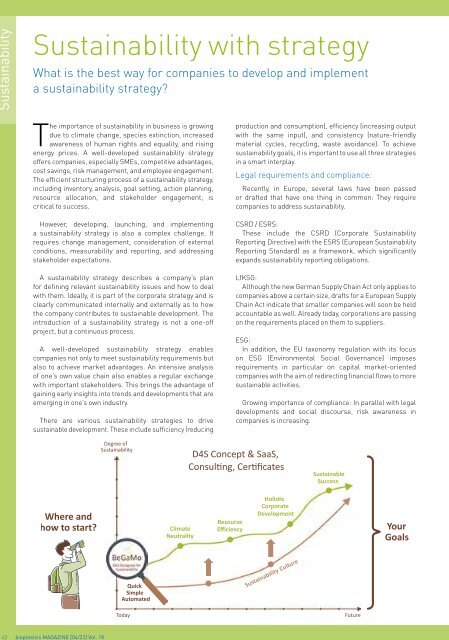Issue 04/2023
Highlights 100th issue Rebranding
Highlights
100th issue
Rebranding
You also want an ePaper? Increase the reach of your titles
YUMPU automatically turns print PDFs into web optimized ePapers that Google loves.
42 bioplastics MAGAZINE [<strong>04</strong>/23] Vol. 18<br />
Sustainability<br />
Sustainability with strategy<br />
What is the best way for companies to develop and implement<br />
a sustainability strategy?<br />
The importance of sustainability in business is growing<br />
due to climate change, species extinction, increased<br />
awareness of human rights and equality, and rising<br />
energy prices. A well-developed sustainability strategy<br />
offers companies, especially SMEs, competitive advantages,<br />
cost savings, risk management, and employee engagement.<br />
The efficient structuring process of a sustainability strategy,<br />
including inventory, analysis, goal setting, action planning,<br />
resource allocation, and stakeholder engagement, is<br />
critical to success.<br />
However, developing, launching, and implementing<br />
a sustainability strategy is also a complex challenge. It<br />
requires change management, consideration of external<br />
conditions, measurability and reporting, and addressing<br />
stakeholder expectations.<br />
A sustainability strategy describes a company’s plan<br />
for defining relevant sustainability issues and how to deal<br />
with them. Ideally, it is part of the corporate strategy and is<br />
clearly communicated internally and externally as to how<br />
the company contributes to sustainable development. The<br />
introduction of a sustainability strategy is not a one-off<br />
project, but a continuous process.<br />
A well-developed sustainability strategy enables<br />
companies not only to meet sustainability requirements but<br />
also to achieve market advantages. An intensive analysis<br />
of one’s own value chain also enables a regular exchange<br />
with important stakeholders. This brings the advantage of<br />
gaining early insights into trends and developments that are<br />
emerging in one’s own industry.<br />
There are various sustainability strategies to drive<br />
sustainable development. These include sufficiency (reducing<br />
production and consumption), efficiency (increasing output<br />
with the same input), and consistency (nature-friendly<br />
material cycles, recycling, waste avoidance). To achieve<br />
sustainability goals, it is important to use all three strategies<br />
in a smart interplay.<br />
Legal requirements and compliance:<br />
Recently, in Europe, several laws have been passed<br />
or drafted that have one thing in common: They require<br />
companies to address sustainability.<br />
CSRD / ESRS:<br />
These include the CSRD (Corporate Sustainability<br />
Reporting Directive) with the ESRS (European Sustainability<br />
Reporting Standard) as a framework, which significantly<br />
expands sustainability reporting obligations.<br />
LfKSG:<br />
Although the new German Supply Chain Act only applies to<br />
companies above a certain size, drafts for a European Supply<br />
Chain Act indicate that smaller companies will soon be held<br />
accountable as well. Already today, corporations are passing<br />
on the requirements placed on them to suppliers.<br />
ESG:<br />
In addition, the EU taxonomy regulation with its focus<br />
on ESG (Environmental Social Governance) imposes<br />
requirements in particular on capital market-oriented<br />
companies with the aim of redirecting financial flows to more<br />
sustainable activities.<br />
Growing importance of compliance: In parallel with legal<br />
developments and social discourse, risk awareness in<br />
companies is increasing.

















